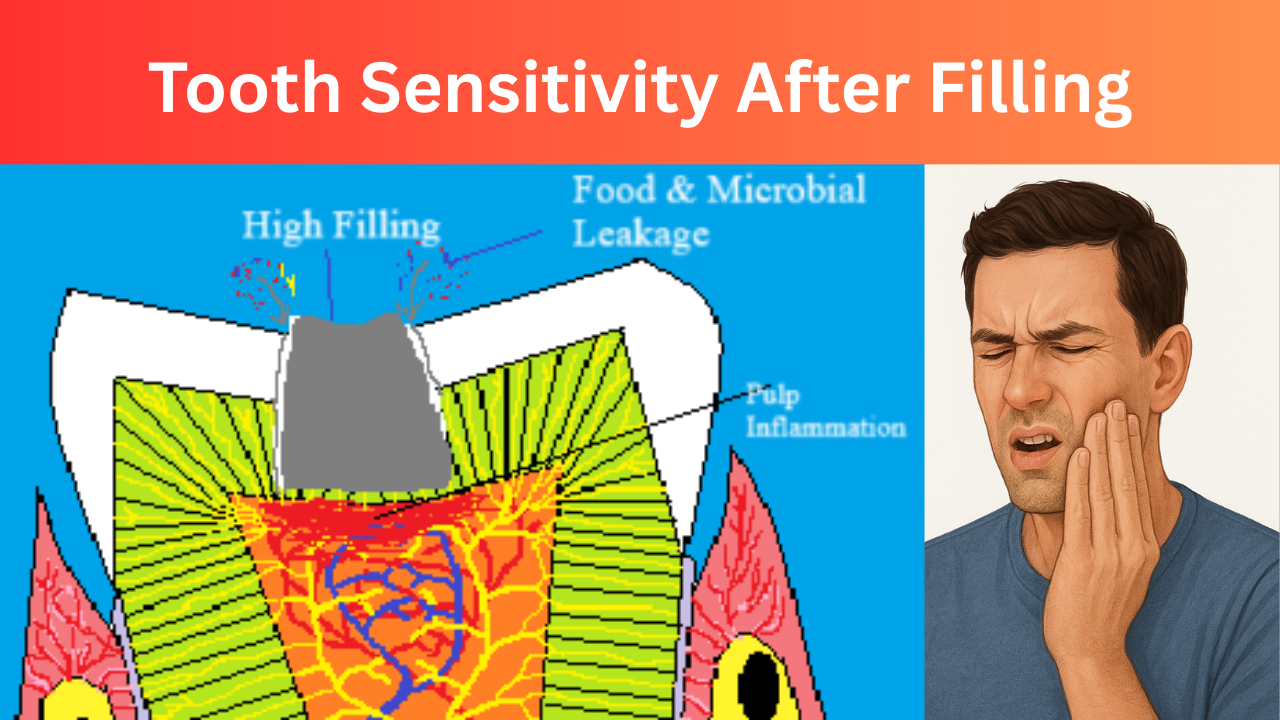
Tooth Sensitivity After Filling
Tooth sensitivity after filling is a common concern that many patients experience. While a mild level of sensitivity is normal after a dental filling, understanding the underlying causes, when to worry, and how to relieve discomfort can help ease anxiety and ensure proper care. This article covers everything you need to know about tooth sensitivity after filling and how to manage it effectively.
What Causes Tooth Sensitivity After Filling?
- Nerve Irritation
- When a dentist removes decay and places a filling, it can cause temporary inflammation in the tooth’s pulp (the innermost layer containing nerves). This can lead to sensitivity, especially to hot, cold, sweet, or pressure.
- Type of Filling Material
- Composite resin fillings, which are tooth-colored, can shrink slightly during hardening. This shrinkage may create small gaps or pressure on the tooth, leading to sensitivity.
- Metal amalgam fillings may conduct temperature changes more readily, causing thermal sensitivity.
- Bite Issues (High Filling)
- If the filling is too high or not shaped correctly, it can affect how your teeth come together when you bite, putting pressure on the filled tooth and causing discomfort or sensitivity.
- Exposed Dentin
- If the decay was deep, it might have exposed or come close to the dentin, the sensitive layer beneath the enamel, increasing the chances of sensitivity.
- Pulpitis (Reversible or Irreversible)
- Reversible pulpitis causes temporary sensitivity, which subsides on its own. Irreversible pulpitis, however, may require root canal treatment and is usually accompanied by constant or severe pain.
How Long Does Tooth Sensitivity Last After a Filling?
- Mild sensitivity typically lasts for a few days to a couple of weeks.
- Sensitivity should gradually decrease as the tooth heals.
- If discomfort worsens or lasts more than 2–4 weeks, you should consult your dentist.
What Triggers Sensitivity After a Filling?
- Cold or hot foods and drinks
- Sweet foods or beverages
- Chewing or biting down
- Brushing around the filled tooth
When Should You Be Concerned?
Seek your dentist’s help if you notice:
- Sensitivity that worsens over time
- Sharp pain when biting or chewing
- Pain that lingers for minutes or hours
- Swelling, fever, or signs of infection
- Discomfort months after the filling procedure
These could indicate an underlying issue such as an improperly placed filling, bite misalignment, or deeper nerve involvement.
How to Get Relief from Tooth Sensitivity After Filling
- Use Desensitizing Toothpaste
- Toothpastes like Sensodyne can block nerve signals to reduce sensitivity.
- Avoid Trigger Foods
- Stay away from extremely hot, cold, or sugary foods and beverages until sensitivity subsides.
- Take Pain Relievers
- Over-the-counter pain relievers like ibuprofen or paracetamol can help manage pain temporarily.
- Avoid Aggressive Brushing
- Use a soft-bristled toothbrush and gentle strokes to prevent irritating the area further.
- Warm Salt Water Rinse
- Rinsing your mouth with warm salt water can reduce inflammation and offer relief.
- Adjust the Filling (If Needed)
- If your bite feels uneven or you suspect the filling is too high, visit your dentist for minor adjustments.
Can You Prevent Sensitivity After a Filling?
- Choose high-quality dental materials suited to your condition.
- Inform your dentist about previous sensitivity experiences.
- Follow proper aftercare instructions.
- Consider a base or liner under the filling for added protection in deep cavities.
Conclusion
Tooth sensitivity after filling is usually a temporary and manageable condition. By understanding its causes and knowing when to seek help, you can take steps to ease discomfort and promote healing. If sensitivity persists beyond a few weeks or worsens, consult your dentist for a thorough evaluation.
Stay tuned for upcoming posts on related topics:
- How long should a filling hurt?
- Sharp pain after filling when biting
- Pain months after filling
FAQs
- Can a tooth filling cause nerve damage?
Yes, deep fillings can sometimes irritate the nerve, potentially leading to inflammation or even requiring a root canal in rare cases. - Why is my tooth sensitive weeks after a filling?
Prolonged sensitivity could be due to high bite pressure, a cracked tooth, or pulpitis (inflammation of the tooth pulp). - Does sensitivity after a filling mean the filling failed?
Not necessarily. Mild sensitivity is common, but severe or worsening pain may indicate issues like leakage or improper bonding. - Can eating hot or cold foods worsen tooth sensitivity after a filling?
Yes, temperature extremes can trigger discomfort, especially in the first few days post-procedure. - Is sensitivity more common with composite (white) fillings than silver (amalgam)?
Yes, composite fillings tend to be more sensitive to temperature changes, especially in deeper cavities. - How long does nerve inflammation last after a filling?
In most cases, it subsides within 1–2 weeks. If it persists or worsens, consult your dentist. - Can sensitive teeth after a filling be treated without replacing the filling?
Often, yes—desensitizing toothpaste, adjusting bite, or fluoride treatment can help manage symptoms. - Are older adults more likely to experience sensitivity after a filling?
Yes, due to receding gums and thinner enamel, older adults may feel more sensitivity after restorative work. - What foods should I avoid after a tooth filling if I have sensitivity?
Avoid very hot, cold, sweet, or acidic foods which may trigger pain in the filled tooth. - Can tooth sensitivity after filling lead to long-term problems?
If untreated, persistent sensitivity could indicate deeper issues like pulpitis or microleakage, which might require further treatment.
